Crystalline – an exhibition of work by artist Siobhán McDonald – is inspired in part by ESA’s Solar Orbiter mission and brings elements of contemporary engineering together with prehistory in the use of carbon and charred bone.
Inspiration takes many forms. Sometimes the catalyst for our imagination can be quite unexpected, as it was when the directors of Parity Studios at University College Dublin (UCD), Ireland, decided to allocate artist Siobhán McDonald some studio space in the UCD physics department. They could not have known of the transformative effect it was going to have on her work: a transformation that culminated in an exhibition running from 26 January to 12 March at the Centre Culturel Irlandais, Paris.
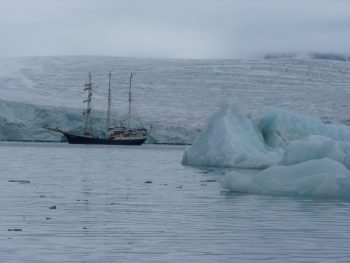
Siobhán sailed on this barquentine tall ship during her Arctic Circle Residency. Photo: Siobhán McDonald.
The exhibition is titled Crystalline and is the product of Siobhán’s research and preparatory work that started in her studio at UCD in 2013 and grew to encompass an expedition to the Arctic Circle in 2015 and a visit to the European Space Agency’s technical centre in the Netherlands in 2016.
Siobhán’s journey began the moment she arrived in the UCD physics department; the impact was immediate. “The artists labs are situated right opposite the physics labs and the corridor was peppered with images of the cosmos. I could hear people talking about what is going on in the world of ecology, geology and physics. Every time I opened my door I entered into this conversation,” Siobhán remembers. “This led me to pursue projects that engaged in a variety of scientific enquiries and I broached subjects at the edges of current scientific knowledge.”
What might have been terra incognita for some, turned into something of a wonderland for Siobhán, who grabbed the opportunity – or rather it grabbed her.
“In a way everything started to imprint itself, or inscribe itself on my psyche. I couldn’t distract myself from the fascinating ideas that permeated the corridor, so I went headlong into talking to the physicists, for hours every week. We would draw parallels in our work and describe how things work mathematically, and then I would paint over it, to make it more tangible for myself. The conversations occurred almost daily because we were so fired up. It was a perfect meeting of the left and right side of the brain. I would research what we talked about and it started to find its way into my work until I could not separate the two worlds. The line between art and science, that veil, disappeared because I didn’t see them as separate disciplines anymore – I saw them as one.”
One of the corridor images that particularly captivated her was of a glittering star field. As she searched for more of the same she found herself being directed to the ESA website time and again. So she decided that the way to make progress was to visit the European Space Research and Technology Centre in the Netherlands. But how? What was the way in? It turned out that fate was laying a trail for her to follow, literally.
“One day, in the O’Brien Centre for Science at UCD, I met John O’Donoghue from Enbio, who was collaborating with the European Space Agency at ESTEC. A bag of charred bone in his hand leaked onto the floor, triggering our conversation about the Solar Orbiter mission and how a revolutionary use of carbon and charred bone is being developed to cover the heatshield of the spacecraft. John invited me to experiment with the materials in a contemporary art context. Together we travelled to ESTEC in 2016. That was when I met people in the Science Directorate and was invited to return to immerse myself in their research.”
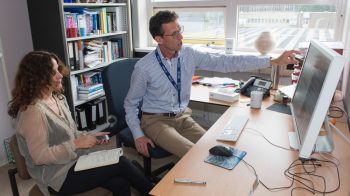
Siobhán with ESA Solar Orbiter project scientist, Daniel Müller, at ESTEC.
Photo: ESA-G. Porter CC BY-SA 3.0 IGO
At ESTEC, Siobhán spent time conversing with scientists who work on some of ESA’s space science missions. Over the course of a few days she explored the workings of the Sun with Daniel Müller and Joe Zender, learning about our star’s explosive power and serene beauty. Philippe Escoubet introduced her to some of the peculiar audio waves, known as whistlers, that have been detected by the Cluster spacecraft as they fly in the near-Earth environment. And there were discoveries closer to home: when viewing the BepiColombo spacecraft in ESTEC’s test centre with Johannes Benkhoff, Siobhán was intrigued by the scale and physical nature of the spacecraft, as well as the materiality of the individual pieces, ranging from the hard metal structures to a protective fabric that is used to protect against the heat of the Sun.
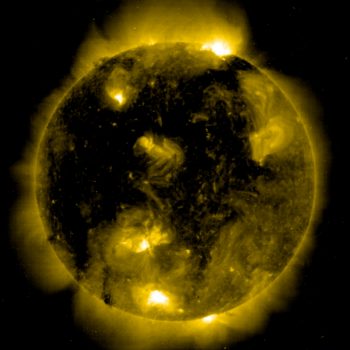
Image of the Sun taken by the EIT instrument on the SOHO spacecraft. Credit: ESA/NASA
This brought her back to the original trigger for visiting ESTEC: the charred bone material, produced by Enbio, that will protect the Solar Orbiter spacecraft from the intense heat of the Sun following its launch in 2018. It is the same kind of material that is found in the crushed animal bone that Stone Age people used to make cave paintings. “There is a clear line transcribed by that material between Solar Orbiter and back into prehistory,” says Siobhán.
As she began to think about using the material in her art, it was ice rather than fire that initially drew her attention.
“I had been to the Arctic and had taken along a heliograph, a device that was historically used to record the Sun. I’m interested in how the Sun is affecting the glaciers and so I attached the heliograph to the binnacle of the expedition ship to create a response to the melting glaciers by recording a score of the Sun’s track at the summer solstice. I recorded messages and pulses as the Sun moved through the sky on 21 June 2015 to produce a series of notations for the score. The burn holes created are photographic in the strictest sense, as each mark is a small black Sun, and each dot is a repeat pattern of the Sun’s image scaled down many million times on its journey to the Earth.”
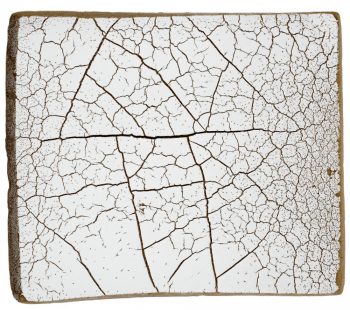
Detail from Crystalline. These pieces are covered with a reflective material mix that is closely related to a protection layer used for radiators on the Solar Orbiter spacecraft. Photo: Vincent Hoban
The culmination of Siobhán’s research in the Arctic and at ESTEC is the body of work that makes up the backbone of the exhibition, Crystalline. It is a series of more than 120 objects that relate to the dying glaciers and that bring the elements of contemporary engineering together with prehistory in the use of carbon and charred bone.
The surfaces for Crystalline are cured at high temperatures to create a motif of cracked and disjointed cartographies. “They exude an air of disrupted beauty,” says Siobhán. “Each piece is covered in this contemporary reflective material mix that is closely related to the protective layer used on some Solar Orbiter surfaces. Maybe people will look at it and think about the typography created over centuries by the moving glaciers and how that will change.”
There is also a sound piece that accompanies the exhibition. “While in the Arctic, I recorded the sounds of the exceptionally fragile region because in 20 years time we know that it will have an entirely different frequency. I recorded anything I came into contact with, on and off the boat: the melting ice, the birds, the Arctic terns nesting. The Arctic taught me that sound waves are only a tiny aspect of the limitless vibrations that are untapped in the world. I also made infrasound (low-frequency) recordings with seismology equipment that a geologist had given me. I came back with lots of recordings as well as the heliograph ‘score’ of the Sun’s track. For the next 18 months I worked with composer Irene Buckley to develop a sound piece that would be a score to what is happening in the Arctic.”
The soundscape is the backdrop to a four-minute film made with Christopher Ash, in which footage recorded in the Arctic is merged with paintings and other images inspired by Siobhán’s time there. Included also are images of the Sun and recording of whistlers sourced during Siobhán’s time at ESTEC.
[Above: This 4-minute video, At the Edge of Visibility, 2016, is part of the Crystalline exhibition.]
The show also includes a series Oil paintings based on photographic plates found in the remains of several Arctic expeditions during the 18th century. Another work, Cyathea Australis (2016), consists of four photogenic drawings that narrate the changing state of the Earth’s atmosphere. This work investigates the early tools of photography by reducing this medium to its bare essentials in a series of photogenic drawings that interrogate an era before the Anthropocene. The silhouettes of the earliest plants in this series are generated by a 400-million-year-old atmosphere. But it is the fragile cracked surfaces of the Crystalline pieces that Siobhán hopes will draw people in and make them curious to learn more.
“In the process of following this enquiry, many other enquiries have emerged – my exhibition in Paris is certainly a point of resolution of some of these, but many other stories have opened up, and the interconnectedness of the parts has been astonishing,” she says.
Crystalline, curated by Helen Carey, is on display at Centre Cultural Irlandais, Paris from 26 January to 12 March.
Siobhán McDonald was interviewed by Stuart Clark for the art&science@ESA blog.

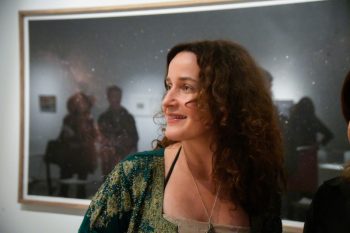

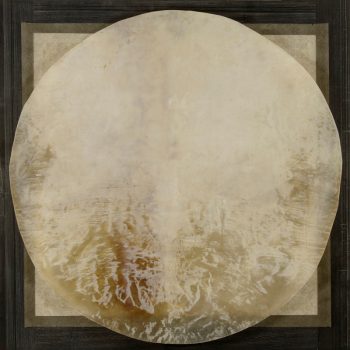
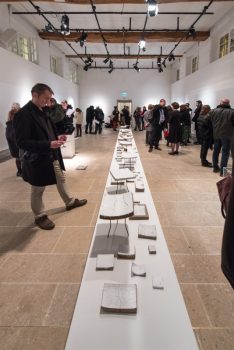
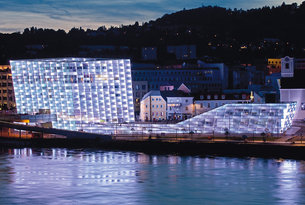

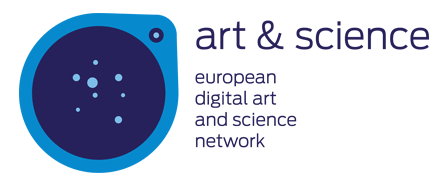
Discussion: no comments